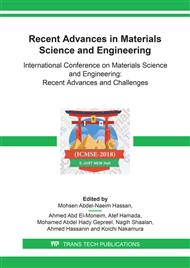[1]
I. Arora, J. Samuel, and N. Koratkar. Experimental Investigation of the Machinability of Epoxy Reinforced With Graphene Platelets. Journal of Manufacturing Science and Engineering, 135 (2013), pp.041007-7.
DOI: 10.1115/1.4024814
Google Scholar
[2]
G. Marsh. Composites get in deep with new-generation engine. Reinforced plastics, 50 (2006), pp.26-29.
DOI: 10.1016/s0034-3617(06)71188-2
Google Scholar
[3]
R. Singh. Dynamic design of automotive systems: Engine mounts and structural joints. Sadhana, 25 (2000), pp.319-330.
DOI: 10.1007/bf02703548
Google Scholar
[4]
J. Wei, T. Vo, and F. Inam. Epoxy/graphene nanocomposites - processing and properties: a review. RSC Advances, 5 (2015), pp.73510-73524.
DOI: 10.1039/c5ra13897c
Google Scholar
[5]
S. Bhuvana1 and M. Prabakaran. Synthesis and Characterisation of Polyamide/Halloysite Nanocomposites Prepared by Solution Intercalation Method. Nanoscience and Nanotechnology, 4 (2014), pp.44-51.
Google Scholar
[6]
M. S. Saharudin, R. Atif, I. Shyha, and F. Inam. The degradation of mechanical properties in halloysite nanoclay–polyester nanocomposites exposed to diluted methanol. Journal of Composite Materials, 51 (2017), pp.1653-1664.
DOI: 10.1177/0021998316660178
Google Scholar
[7]
R. Ramachandran, V. Mani, S.-M. Chen, R. Saraswathi, and B.-S. Lou. Recent trends in graphene based electrode materials for energy storage devices and sensors applications. Int. J. Electrochem. Sci, 8 (2013), pp.11680-11694.
Google Scholar
[8]
Z. Tehrani, G. Burwell, M. M. Azmi, A. Castaing, R. Rickman, J. Almarashi, et al. Generic epitaxial graphene biosensors for ultrasensitive detection of cancer risk biomarker. 2D Materials, 1 (2014), p.025004.
DOI: 10.1088/2053-1583/1/2/025004
Google Scholar
[9]
S. Chun, Y. Kim, H. Jin, E. Choi, S.-B. Lee, and W. Park. A graphene force sensor with pressure-amplifying structure. Carbon, 78 (2014), pp.601-608.
DOI: 10.1016/j.carbon.2014.07.051
Google Scholar
[10]
Y. Wu, Y.-m. Lin, A. A. Bol, K. A. Jenkins, F. Xia, D. B. Farmer, et al. High-frequency, scaled graphene transistors on diamond-like carbon. Nature, 472 (2011), p.74.
DOI: 10.1038/nature09979
Google Scholar
[11]
C. Liu, Z. Yu, D. Neff, A. Zhamu, and B. Z. Jang. Graphene-based supercapacitor with an ultrahigh energy density. Nano letters, 10 (2010), pp.4863-4868.
DOI: 10.1021/nl102661q
Google Scholar
[12]
K. S. Novoselov, A. K. Geim, S. Morozov, D. Jiang, M. Katsnelson, I. Grigorieva, et al. Two-dimensional gas of massless Dirac fermions in graphene. nature, 438 (2005), p.197.
DOI: 10.1038/nature04233
Google Scholar
[13]
L. Chen, H. Xie, W. Yu, B. Wang, and Z. Wu. Thermal transport behaviors of suspended graphene sheets with different sizes. International Journal of Thermal Sciences, 94 (2015), pp.221-227.
DOI: 10.1016/j.ijthermalsci.2015.03.010
Google Scholar
[14]
R. Zhang, Y. Luo, S. Qi, and X. Xu. Long-range ferromagnetic graphene via compensated Fe/NO2 co-doping. Applied Surface Science, 305 (2014), pp.768-773.
DOI: 10.1016/j.apsusc.2014.03.195
Google Scholar
[15]
M. Poljak, K. L. Wang, and T. Suligoj. Variability of bandgap and carrier mobility caused by edge defects in ultra-narrow graphene nanoribbons. Solid-State Electronics, 108 (2015), pp.67-74.
DOI: 10.1016/j.sse.2014.12.012
Google Scholar
[16]
J. Jia, D. Shi, X. Feng, and G. Chen. Electromechanical properties of armchair graphene nanoribbons under local torsion. Carbon, 76 (2014), pp.54-63.
DOI: 10.1016/j.carbon.2014.04.048
Google Scholar
[17]
M. Y. Han, B. Özyilmaz, Y. Zhang, and P. Kim. Energy band-gap engineering of graphene nanoribbons. Physical review letters, 98 (2007), p.206805.
DOI: 10.1103/physrevlett.98.206805
Google Scholar
[18]
S. Wang, M. Tambraparni, J. Qiu, J. Tipton, and D. Dean. Thermal expansion of graphene composites. Macromolecules, 42 (2009), pp.5251-5255.
DOI: 10.1021/ma900631c
Google Scholar
[19]
M. N. Kumar, M. Mahmoodi, M. TabkhPaz, S. Park, and X. Jin. Characterization and micro end milling of graphene nano platelet and carbon nanotube filled nanocomposites. Journal of Materials Processing Technology, 249 (2017), pp.96-107.
DOI: 10.1016/j.jmatprotec.2017.06.005
Google Scholar
[20]
M. M., Characterization and Micro End Milling of Graphene Nano Platelet,, presented at the Proceeding of the 8th International Conference on Micro Manufacturing, (2013).
Google Scholar
[21]
H. Tian, Y. Shu, X.-F. Wang, M. A. Mohammad, Z. Bie, Q.-Y. Xie, et al. A graphene-based resistive pressure sensor with record-high sensitivity in a wide pressure range. Scientific reports, 5 (2015), p.8603.
DOI: 10.1038/srep08603
Google Scholar
[22]
W.-H. Kim, C. S. Park, and J. Y. Son. Nanoscale resistive switching memory device composed of NiO nanodot and graphene nanoribbon nanogap electrodes. Carbon, 79 (2014), pp.388-392.
DOI: 10.1016/j.carbon.2014.07.081
Google Scholar
[23]
M. Camara, J. C. Rubio, A. Abrão, and J. Davim. State of the art on micromilling of materials, a review. Journal of Materials Science & Technology, 28 (2012), pp.673-685.
DOI: 10.1016/s1005-0302(12)60115-7
Google Scholar
[24]
J. Samuel, Fundamental study of the machinability of carbon nanotube reinforced polymer composites: University of Illinois at Urbana-Champaign, (2009).
Google Scholar
[25]
C. Goo, L. Hyunh, C. Papadopoulos, and B. Jun. Experimental investigation of the machinability of polystyrene reinforced with single-walled carbon nanotubes. Proceedings of NAMRI/SME, 39 (2011).
Google Scholar
[26]
M. Mahmoodi, M. Malekian, J. Mueller, M. Jun, and S. Park. Machinability of Aligned CNT Nanocomposites ICOMM. composites, 12, p.14.
Google Scholar
[27]
M. Mahmoodi, M. Arjmand, U. Sundararaj, and S. Park. The electrical conductivity and electromagnetic interference shielding of injection molded multi-walled carbon nanotube/polystyrene composites. Carbon, 50 (2012), pp.1455-1464.
DOI: 10.1016/j.carbon.2011.11.004
Google Scholar
[28]
X. Teng, D. Huo, I. Shyha, W. Chen, and E. Wong. An experimental study on tool wear behaviour in micro milling of nano Mg/Ti metal matrix composites. The International Journal of Advanced Manufacturing Technology, (2018).
DOI: 10.1007/s00170-018-1672-z
Google Scholar


